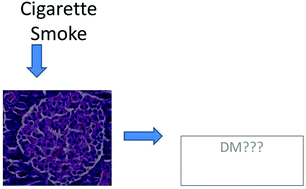Pancreatic damage induced by cigarette smoke: the specific pathological effects of cigarette smoke in the rat model
Abstract
In recent years, pancreatic pathologies have become common problems and their etiology and pathogenesis are generally unknown. Studies have shown that smoking may increase the risk of pancreatic disorders but very scant knowledge is available about the pathogenesis of cigarette induced pancreatic pathology. This study aimed to evaluate the oxidative stress status, biochemical, pathological and immunohistochemical findings of rats exposed to cigarette smoke, pathogenesis of smoking related pancreatic damage and usability of Alpha Lipoic Acid (ALA) for amelioration of cigarette smoking induced harmful effects on rat pancreas. Twenty eight female, Sprague Dawley rats were randomly distributed into three groups. The sham group (S) (n = 8), rats were given 0.1 ml of physiological serum by oral gavage for 8 weeks. The cigarette smoke exposed group (CSE) (n = 10), rats were exposed to successive periods of cigarette smoke for 2 hours per day per 8 weeks and given 0.1 ml of physiological serum orally during the study. The cigarette smoke exposed and ALA treated group (CSE + ALA) (n = 10), animals were exposed to cigarette smoke (2 hours per day per 8 weeks) and simultaneously treated with 100 mg per kg per day ALA orally during the study. At the end of the study, the serum samples were collected for insulin, glucagon, glucose and amylase analyses. Tissue samples were collected for biochemical, histopathological and immunohistochemical examinations. Total oxidant status (TOS), total antioxidant status (TAS) levels and oxidative stress index (OSI) were evaluated in the pancreas samples. Immunohistochemical analyses of insulin, glucagon, calcitonin gene related protein (CGRP), active caspase-3, hypoxia inducible factor-1 (Hif-1), Hif-2 and tumor necrosis factor (TNF-α) expressions of pancreas were examined. Cigarette smoke caused statistically significant increase in serum amylase and glucose but decreased insulin levels indicating both endocrine and exocrine cell damage. There were no statistically significant differences in serum glucagon levels between the groups. Histopathological examination of the pancreas exhibited generally normal tissue architecture but slightly degenerative and apoptotic cells were noticed both in the endocrine and exocrine part of the pancreas in the CSE group. Immunohistochemical analyses revealed marked increase in active caspase-3, Hif-1 and Hif-2, CGRP and TNF-α expressions with a slight increase in glucagon immunoreactivity in cells while a marked decrease was observed in insulin expression in some Langerhans islets in the CSE group. ALA ameliorated biochemical and pathological findings in the CSE + ALA group. These findings clearly demonstrated that cigarette smoke can cause damage in both endocrine and exocrine cells in rat pancreas and ALA has an ameliorative effect of cigarette induced lesions.


 Please wait while we load your content...
Please wait while we load your content...